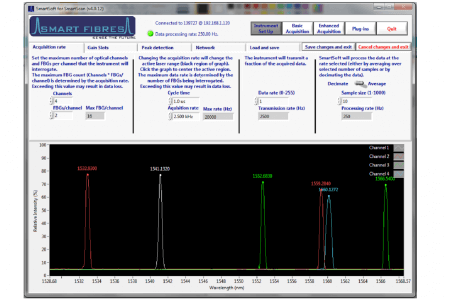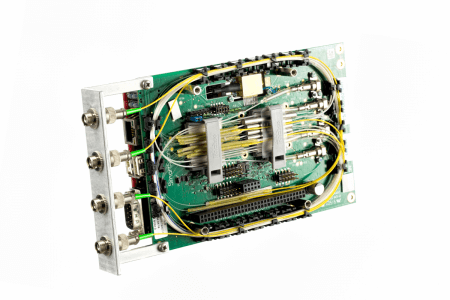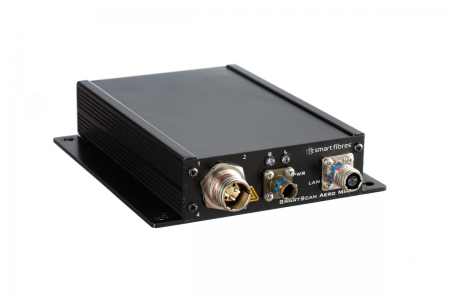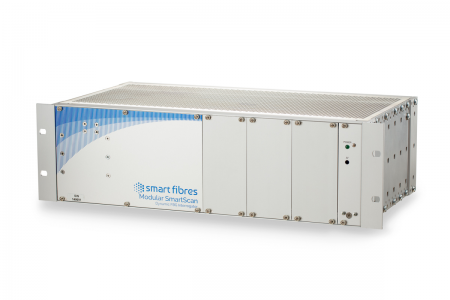- Our Products
- SmartScan
SmartScan

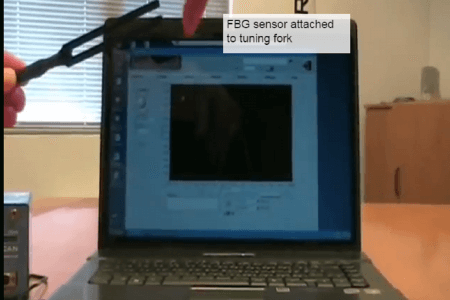
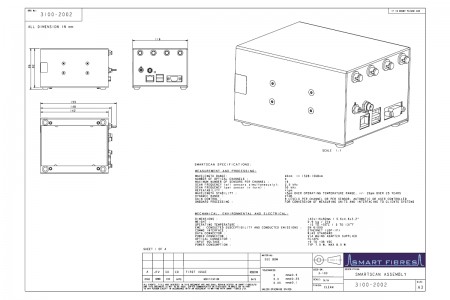
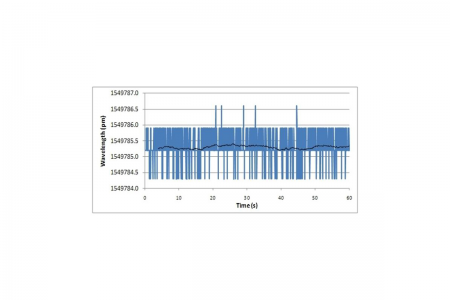
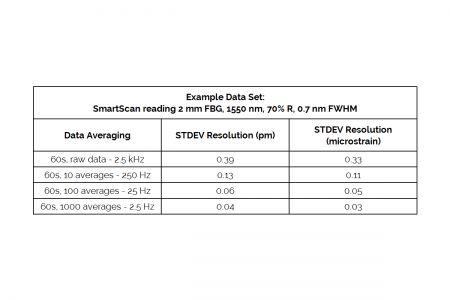





SmartScan is an ultra-compact and robust interrogator for dynamic measurement of FBG sensors. This WDM instrument is based on an agile, tuneable laser source that enables high resolution interrogation at multi kHz frequencies. The high frequency scan rates allow over-sampling and averaging to give extraordinary resolution.
Data can be written to an Ethernet or other industrial bus interface, or saved to a connected USB device.
Why Choose a Smart Fibres Interrogator?
Features:
- Multi-kHz scanning
- Ultra compact
- All solid state
- Highly robust optics (flight tested variants available)
- Data logging to USB drive option
Related Products
Related FAQs
FAQ. What is the warranty period for Smart Fibres' interrogators?
All of our fibre optic interrogators come with a standard one year warranty. This warranty can be increased on a year by year basis. Extended warranty is available at the time of initial purchase on request.
FAQ. Can the acquisition system make a measurement at a fast scan rate and then average these values over a longer time period?
Yes, SmartSoft software has the functionality for the user to set both the scan rate and averaging rate. This will reduce the number of data points being logged to file.
FAQ. Can I increase the SmartScan scan rate higher than 2.5 kHz?
Yes, the scan rate is user definable in the SmartSoft software. Table below gives an indication of the scan rates available:
| Scan Rate (All channels simultaneously) | Scan Bandwidth |
2.5 kHz | 40 nm |
5 kHz | 20 nm |
10 kHz | 10 nm |
20kHz | 5nm |
FAQ. Can SmartScan synchronise to a National Time Protocol (NTP) server?
SmartScan can synchronise to a NTP time signal via its Ethernet port.
In this scenario SmartScan would need to be connected on a Local Area Network (LAN) and would also need to be able to access an NTP server, either on the same LAN or over the Internet.
All the data from SmartScan is time stamped, so if an NTP signal is received the timestamps would be synchronised to that signal. See “Plug-in for NTP synchronisation” in the SmartSoft user manual.
FAQ. Is data averaging done on the instrument itself?
No on-board averaging is done. Averaging is done in SmartSoft on the PC connected to the instrument.
FAQ. Can I synchronise SmartScan data with data from other types of measurement system?
All data from SmartScan is transmitted with a Universal Time Coordinated (UTC) time stamp. The SmartScan’s UTC time is synchronised with the host PC’s clock every time SmartSoft connects to the interrogator. Therefore SmartScan data can be synchronised with time stamped data from other measurement systems.
FAQ. Can you recommend a PC specification for use with Smart Fibres' interrogators?
Generally speaking the faster the processor speed and the newer the processor technology the more likely it is to cope with the speed of data. Nearly all new off-the-shelf laptops and desktops would be fast enough, and these typically have an i3 with a processor speed of 2 GHz or better. Older desktops with Intel Duo ~3 GHz processors are also fast enough.
FAQ. Does Smart Fibres offer after sales support?
Yes, we offer free telephone and email support to our customers.
Please Email Technical Support or call +44 1344 484111.
FAQ. What software is supplied with an FBG interrogator?
All of our interrogators are supplied with our standard SmartSoft suite of LabVIEW based applications.
For further information about SmartSoft please visit our SmartSoft Software Product Page via the below link.
For options about customising the software, please refer to our further FAQ below.
FAQ. Does Smart Fibres offer field installation services?
Yes, our highly experienced team of field installation engineers can be mobilized to install our systems or sensors anywhere around the globe.
For more information please Email Us or call +44 1344 484111.
FAQ. Why do you recommend using an FBG with a >0.5 nm FWHM for SmartScan instruments?
The algorithm embedded in the SmartScan needs several laser tuning points to overlap the reflection shape of the FBG. In order to achieve a non-linearity error compatible with the SmartScan Specifications, we recommend to use FBG with an FWHM between 0.5 and 1 nm.
Narrower FBGs can be used, at the expense of reduced linearity.
Please Email Technical Support or call +44 1344 484111 if you need more help on this point.
FAQ. How reliable are FBG sensors?
Optical fibre fatigue reliability is very high and FBG sensors benefit from this fact. For instance, client tests found that Smart Fibres’ SmartPatch sensors were still 100 % functional after 6 x107 cycles of tensile and compressive fatigue loading.
FAQ. Is it possible to check or change the IP address of the instrument via a RS232 connection?
Yes. Please contact us at Email Technical Support or call +44 1344 484111 for the connection procedure and assistance.
FAQ. How do I calculate which wavelength to use for my FBGs to maximise the number of sensors on a particular channel?
Smart Fibres has created a wavelength budget calculation tool for FBG wavelength selection.
Please Email Us or call +44 1344 484111 with details of your application and we can help you create a wavelength budget.
FAQ. How many optical splitter/combiners can be used in a single channel?
Our instruments have a dynamic range of 27 dB optical power. The table below gives a rough estimate of each device’s loss.
When using low reflectivity FBGs such as drawtower gratings the optical power budget is reduced from 27 dB to 11 dB.
| Device | Optical loss |
1 x 2 coupler | 6db |
1 x 4 coupler | 12db |
1 x 8 coupler | 18db |
FC/APC Uniter | 1db |
FAQ. Can a SmartScan FBG interrogator be operated as a standalone datalogger?
Yes, any SmartScan interrogator can initially be configured with a PC and then disconnected to log the measurement data to a USB solid state storage device or, in the case of SmartScan Aero Mini, it's onboard flash memory.
FAQ. How do I calculate the size of USB stick needed for my data?
Three parameters are needed to calculate the length of data that can be stored: disk size, acquisition rate and number of FBG.
For SmartScan USB data is stored in a raw format.
For 32 FBGs at 2,500 Hz, 100 minutes of data can be stored per GByte of disk space; this can be scaled proportionally to number of FBGs or acquisition rate.
E.g., for 16 FBGs at 2,500 Hz, 200 minutes / GByte
E.g., for 32 FBGs at 500 Hz, 500 minutes / GByte
E.g., for 16 FBGs at 250 Hz, 2,000 minutes / GByte
For SmartScope, data would likely be processed into measurement units, so it would be in the same format as files saved by SmartSoft, in which case each measurement uses 10 bytes, plus 10 bytes for the timestamp.
E.g., 32 FBGs = 330 bytes per sample
E.g., 16 FBGs = 170 bytes per sample
E.g., 1 FBG = 20 bytes per sample
E.g., 32 FBGs at 5 Hz = 10,000 minutes / GByte
E.g., 16 FBGs at 5 Hz = 20,000 minutes / GByte
E.g., 32 FBGs at 1 Hz = 50,000 minutes / GByte
E.g., 1 FBG at 1 Hz = 800,000 minutes / GByte or about 18 months / GByte
FAQ. What communications protocol options are available for Smart Fibres interrogators?
For data transmission we can offer Ethernet, CANopen, Modbus/TCP, Modbus/RTU and Profibus DP but not all are available on all our interrogator models.
Please note that some communications protocols will limit the acquisition rates of the instrument, e.g., CANopen is up to 250Hz.
FAQ. Can we connect to the RS232 port for live measurement data?
No, the RS232 port is only used for diagnostics connection.
